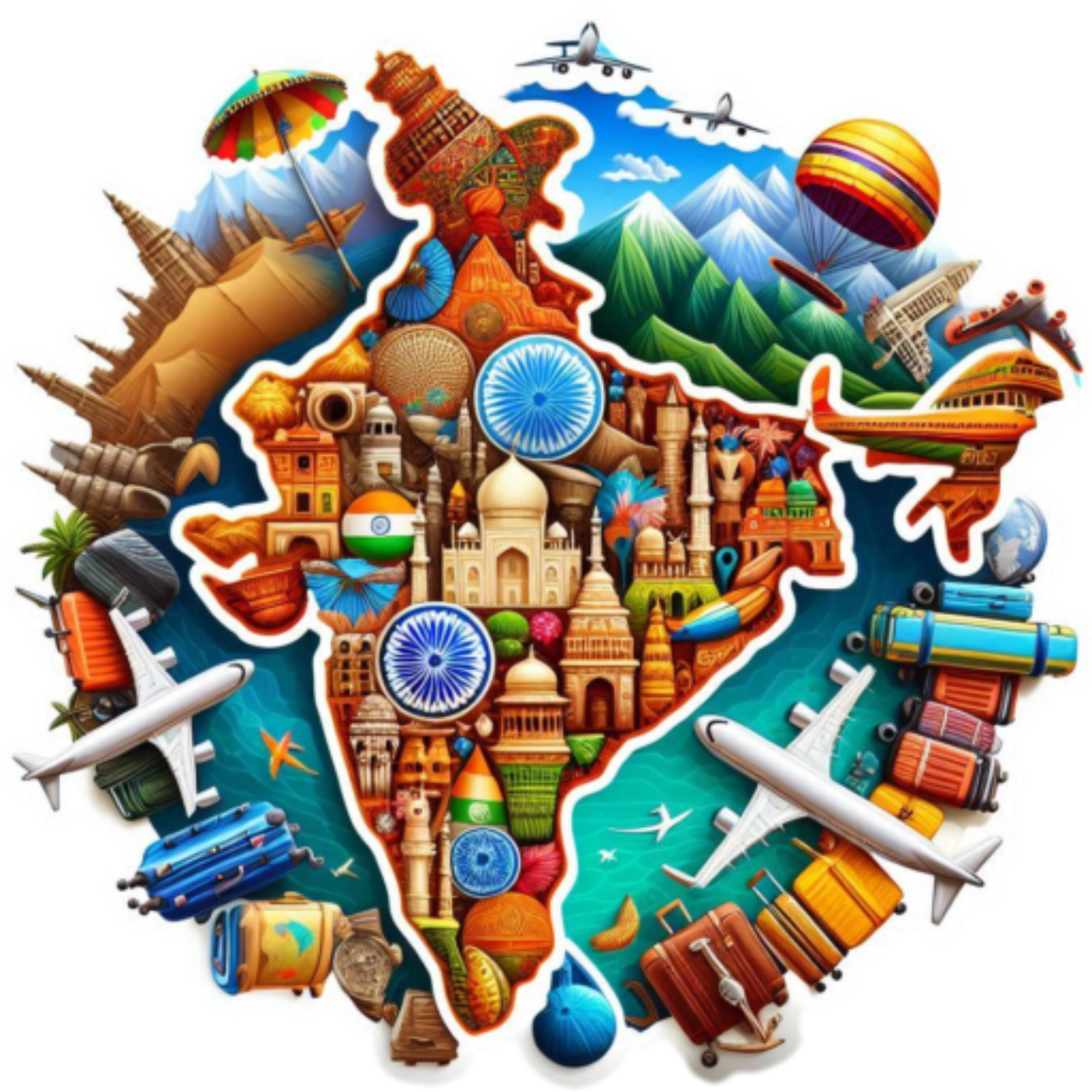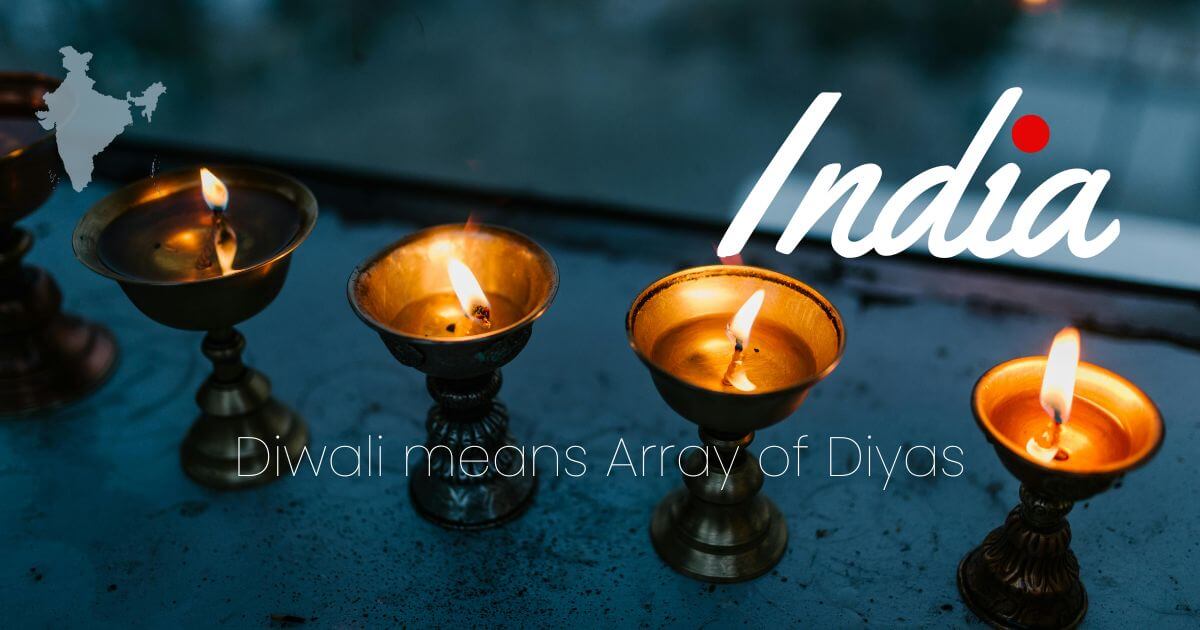Diwali Countdown
Diwali is one of the major festivals in India. It has been gaining tremendous traction internationally, thanks to its great message of victory of good over evil and the Indian diaspora, who celebrates it with passion & devotion.
Diwali’s original name was Deepawali, a compound word of Hindi/Sanskrit. It means Array (Awali) of Clay Lamps (Deep).
So Deepawali = Deep+ Awali
A deep (Diya) is a clay or mud lamp with a cotton wick dipped and soaked in oil or ghee. As the times changed, wax candles came into existence & people started using them along with Diyas. Today, electrical and LED lights have taken the game to another level. However, one thing has remained constant – The Diwali night is bright with illumination, decorations and fireworks. Due to this, it is also called the Festival of Lights.
Why Do We Celebrate Diwali
In India, dates are considered auspicious or inauspicious depending on the combinations of the planets relative to the Earth, sun and moon. Many good (or bad things) happen because of these planetary positions.
Diwali falls in this five-day auspicious window of the autumn months.
In Treta Yuga (starting 2,163,102 BC), Lord Ram returned to Ayodhya from his 14 years of exile on the fifteenth day of the Kartik month. The kingdom celebrated his return by organising prayers and festivals and lighting the streets and homes with Diyas.
Even earlier (as ascribed in Puranas), the Devas (Angels) and Daityas (Demons), in their eternal quest to dominate one another, took to churning the mighty ocean (think tug of war) to take out the treasure buried underneath and divide amongst themselves.
On the thirteenth day of the Kartik month, Lord Dhanavantri, the incarnation of God Vishnu & Goddess Lakshmi, came out of the sea. Both of these deities represent happiness & abundance. Their emergence on the thirteenth day is called Dhanteras.
Dhanatrayodashi = Dhan (Wealth)+ Trayodashi (13th day of the month) = Dhanteras
In Dwapar Yuga ( beginning in 867,102 BC), Lord Krishna, with Goddess Kali, killed a demon called Narakasur on the fourteenth day of the month. Due to this, the day is called Naraka Chaturdas. After killing Naraka, Lord Krishna met his sister Subhadra, who welcomed him and celebrated his return. The meeting of Lord Krishna and Subhadra is celebrated as Bhai Dooj or Bhaubeej, a day after Diwali.
If you noticed, all the tales belong to different periods, but they all happened around the same time of the year. It is because of the repetitive planetary positions during this time. It gives reasons to many Indians, irrespective of their regions or beliefs, to come together and celebrate it like a large family. Diwali symbolizes this community joy.
When is Diwali Celebrated
The calendar devised in ancient India (called Panchang) is very different from the Gregorian calendar. Most Hindus still use it to plan their life events. The dates of most Indian festivals also come from there.
Given this, Diwali falls on the 15th day of the Kartik month (the 8th month of the Hindu Calendar), roughly October or November of the Gregorian Calendar.
It is the best time to be in India (refer to our blog on the best time to visit India).
Diwali is not a standalone, one-day affair! It is a series of five days of celebrations. Here is the breakdown of these five days.
Dhanteras: A day when people pray for everyone’s prosperity & well-being.
It is also the day when people shop for metal articles, jewellery, and white goods and even take deliveries of their cars and homes.
Naraka Chaturdashi: People take early morning bath, apply oil to their body, pray to Lord Sri Krisha and Goddesses Kali and feed poor Brahmins.
Diwali: After the customary prayer to Goddess Lakshmi and other deities, people light lamps and Diyas all over their homes and offices.
Families get together and visit each other with Prasadam and other delicacies.
Children burst crackers and have fun.
Bhaidooj (Bhaubeej): Brothers and Sisters meet each other, follow the rituals and celebrate their togetherness with the entire family.
People refer to the fifteenth day of the Kartik month as Diwali, also the new moon day (Amavasya).
All the celebrations, fireworks and Pooja start on the thirteenth day, peak on the fifteenth day, and then conclude with Bhaidooj.
How do people celebrate Diwali in different parts of India?
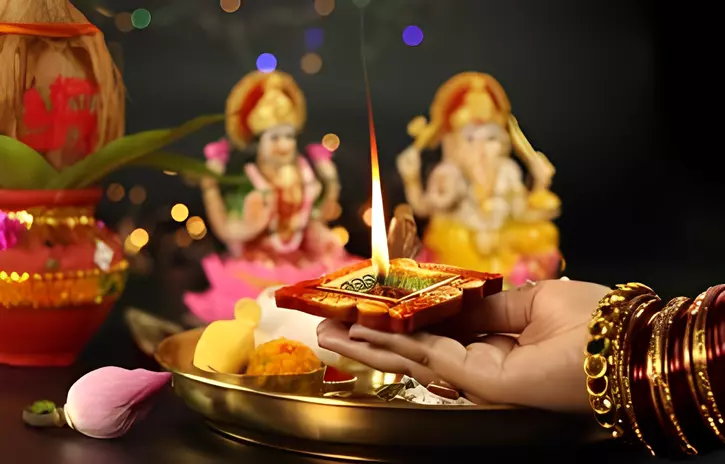
Diwali in Ayodhya
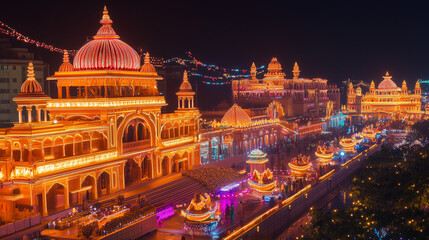
The ancient city of Ayodhya, Lord Sri Ram’s kingdom, is emerging as the focal point of Diwali in northern India.
Even before the inauguration of the glorious Ram Temple, the city of Ayodhya had been setting Guinness World Records for lighting more than 2 million diyas and their sizes.
The event is becoming bigger every year, with an increasing number of tourists visiting the city of Ayodhya to immerse themselves in the spiritual and cultural traditions of the place.
The city is witnessing a massive infrastructural development to accommodate the record number of tourists and pilgrims who have started visiting the site. Most luxury hotel chains have already lined up investments to prepare themselves for the grandest annual event that Uttar Pradesh will see in the future.
The UP State government celebrates Diwali at Ayodhya as Deepotsav. More information about it can be taken from the Deepotsav webiste.
Diwali in Varanasi
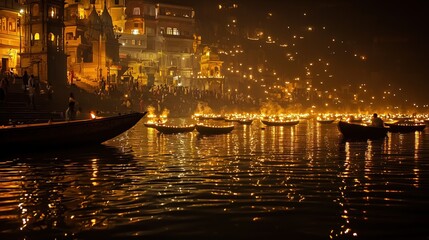
While Diwali is celebrated in Varanasi as it happens elsewhere, the city celebrates another event 15 days after Diwali. It is called Dev Deepawali.
All the ghats are decorated with flowers and Diyas during this period as people take the holy dip in the river Ganges. Brahmins perform grand prayer at the banks with massive Deepams in coordination. It includes chants, incense and prayers that the witnessing crowd also joins. The whole atmosphere is a visual and spiritual splendour, an event that attracts local and international tourists.
Diwali in Gujarat
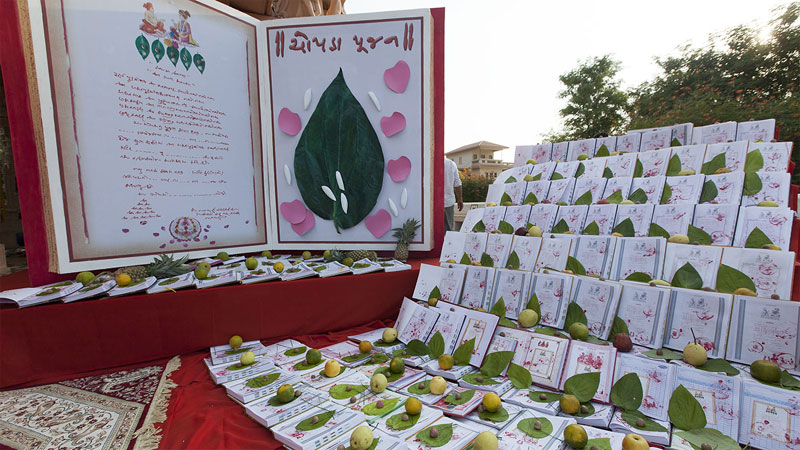
It is time for the New Year in Gujarat, which its business community celebrates by closing its books of accounts and starting afresh with Lakshmi Pooja. This process is done through a ritual where they pay their obeisance to their work, their books (called Chopda) and hope for a brighter future. People decorate their homes and the municipal bodies orgainze events and fireworks at key locations.
Diwali in Udaipur
During the Diwali celebrations, Udaipur, the city of lakes, is decked up grandiosely with lights whose reflections in the lake water look romantic and serene at the same time. People meet up and enjoy food and crackers together.
Udaipur also has its unique ULF (Udaipur Light or Lantern Festival), which is catching up in the tourist circles. It includes mouth-watering food, light, sound, art, lights and festivities amongst the locals and tourists. The highlight of Diwali is the thousands of floating sky lanterns in the Udaipur sky.
Diwali in Punjab
The Sikhs don’t necessarily celebrate the festival strictly as Diwali but as Bandi Chhor Diwas (Liberation Day).
On this day (the 15th day of Kartik month), Guru Hargobind Singhji was released along with many other kings from the captivity of the Mughal King, Jahangir.
The subsequent Gurus made it a point to celebrate this day along with Diwali and Vaishakhi (another Punjabi agricultural festival).
It is also the foundation day of the Golden Temple at Amritsar.
So, Sikhs celebrate this festival by illuminating the temple and fireworks.
Diwali in South India
The southern part of India celebrates comparitively a muted version of the festival, which focuses on Narakasura killing by Lord Krishna.
People visit temples, follow rituals and celebrate with their families ans friends.
Diwali in Delhi
The situation during Diwali in Delhi is turning into a pollution nightmare for many because of its geographical location, climatic conditions and agricultural cycle in the surrounding areas. Farmers in the neighbouring states burn the post-harvest stubble to clear their fields. The resultant smoke hangs above Delhi’s air and takes up the Delhi AQI levels to 30 times higher than WHO-prescribed levels! The government is mulling over steps to tackle this. So far, there doesn’t seem to be any solution due to political reasons.
For international tourists, it is best to avoid Delhi during this period. They can head to Mumbai to witness the urban festivities.
Diwali in Mumbai
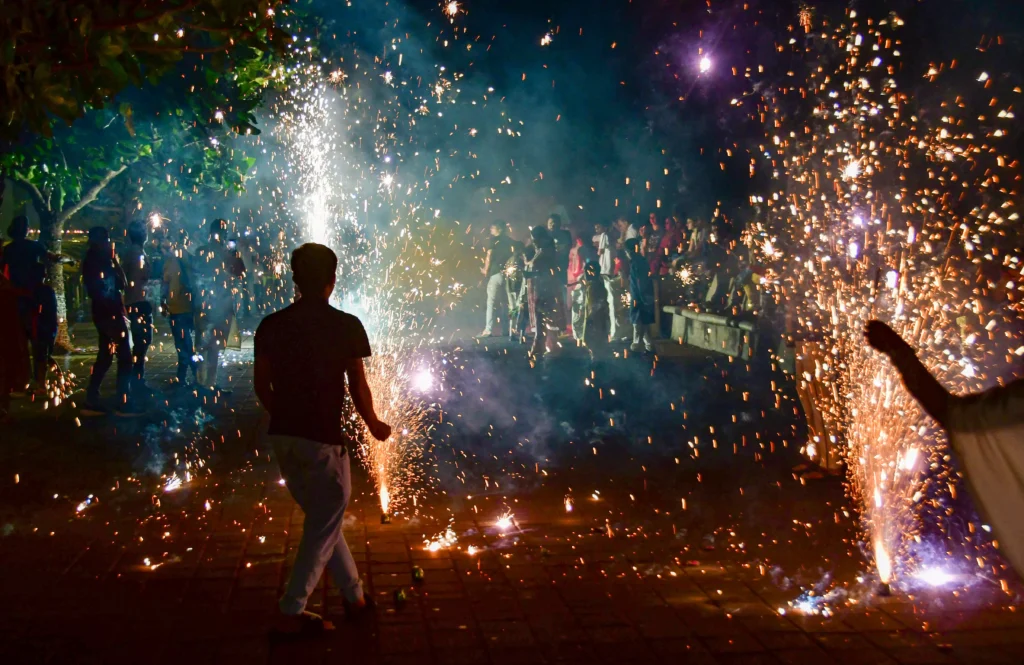
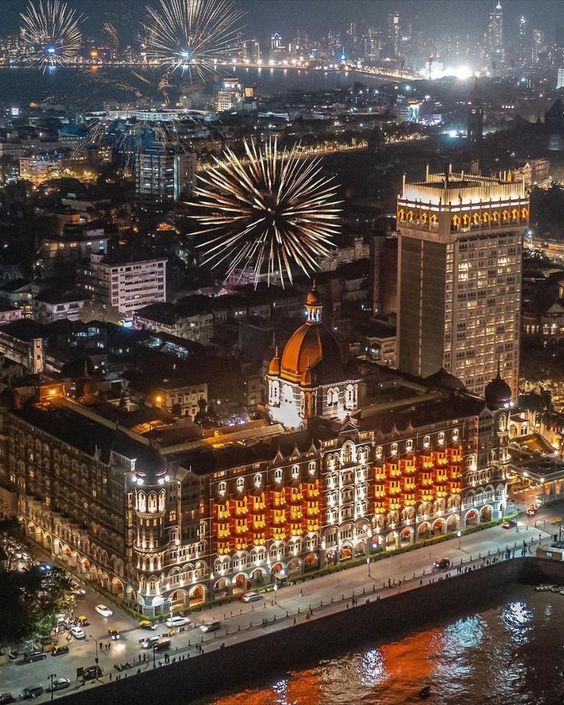
Diwali in Mumbai looks like a movie set. People venture out to the seafronts to get together and burst crackers. The merchant bodies of prominent high streets decorate the market with lights and organise food and shopping events. The city is a little humid, but it doesn’t discourage women from dressing up in heavy traditional dresses and jewellery.
How do Jains celebrate Diwali
Like many Hindu communities, Jains also celebrate the following day of Diwali as the New Year.
Lord Mahavira, their supreme preacher, attained Nirvana on this day.
They celebrate it by reflecting on their past and renewing their spiritual plans in the New Year.
What is the correct date for Diwali in 2024?
In 2024, the Muhoorat (the most auspicious time) to celebrate the festival is a complicated calculation, and there is no consensus yet if it will be on the 31st of October or the 1st of November.
What is the confusion?
Let us try to explain in simple words.
The Lakshmi Pooja Muhoorat, an important and the starting point of Diwali is on the 31st of October between 5:36 PM and 6:16 PM.
However, the new moon day (Amavasya) gets over in the morning after the sunrise on the 1st.
It makes the 1st of November an equally viable date.
Well, we can leave these calculations to the Pundits & Brahmins.
What matters most is to enjoy the festivities & enjoy the camaraderie.
And for that, two days are better than one.
As of now, it looks like the most fireworks and celebrations will be on the 31st.
But, we are sure people will continue celebrating and enjoying the festivities beyond the 31st or 1st and have fun till they are dead tired.
